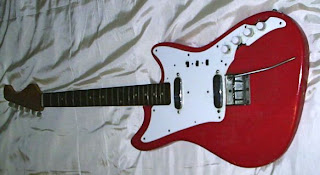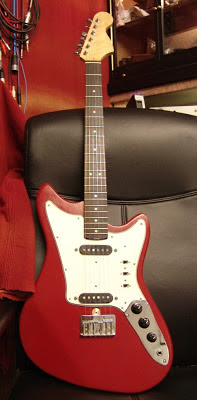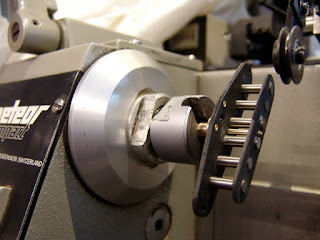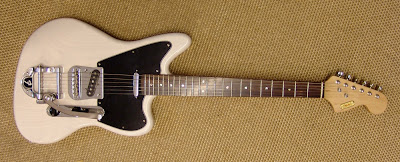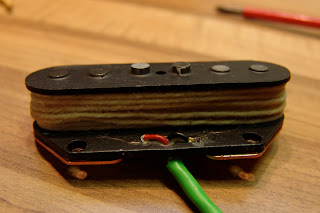My holiday project was assembling this Telemaster guitar, from parts acquired that I have accumulated over the past six months or so.
 |
| Fender (ish) Telemaster guitar, Xaudia |
The ‘Telemaster’ is an imagined product that Fender might have made in the 1960s or 70s, but never did – it is essentially a Jazzmaster body with Telecaster hardware. In this case I used a neck with a Strat-style headstock, and added a Fender-badged Bigsby vibrato, simply because I love the Bigsby sound.
The ash body & scratch plate were made and sprayed by John Manuel of Carlisle, who did an amazing job with a nitrocellulose transparent white – it really shows the lovely grain below. He can be contacted through ebay.
The neck and locking tuners were from Vanson guitars. The neck is pretty nice quality, although I did need to rub it down with some very fine abrasive paper to remove a couple of rough spots in the varnish. I found it slightly chunkier in profile than an original Jazzmaster neck.
 |
| Bigsby with super-tremola upgrade |
One thing that I don’t love about Bigsbys is re-stringing them. The ball ends of the strings have a tendency to slip off the metal posts, which can be very frustrating, and one really needs four hands for the job – to hold the string at both ends, keep in under tension, and turn the tuner! Two things help with this – firstly locking tuners clamp the string at that end, and also I have fitted a Duesenberg super tremola kit, from Rockinger, which replaces the posts with a through-hole system. Much less frustrating!
 |
| home made telecaster pickup |
The pickups are of course home made, and I tried to get as close to the original Telecaster specs as I could. Rather than using a bobbin/former to wind the coil, the core of the pickups were made using top and bottom ‘flatwork’, glued to Alnico rods. Enamelled wire was then wound directly onto the magnets, which avoids the gap between magnets and wire that is inherent with a plastic former.
The bridge pickup was wound with 8500 turns of 42 gauge wire, and the bridge was reverse-wound with around 6500 turns of 43 gauge, and of course reverse polarity for the magnets. Once wound, the pickups are wrapped with string to protect the delicate coil, and then dipped in wax to stop microphonics. The whole thing is very solid, and rather heavy.
I did briefly consider adding a headstock decal to complete the fake Fender look, but decided that it was too good to give anyone else the credit – so it has a nice Xaudia badge. I am rather proud of it! 🙂
